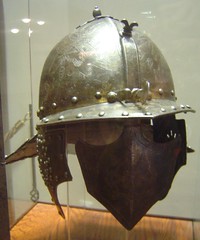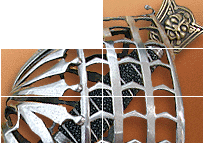| Author |
Message |
|
Renzo Rebagliati
|
 Posted: Sat 13 Dec, 2014 2:20 pm Post subject: Help identifying medieval helmet Posted: Sat 13 Dec, 2014 2:20 pm Post subject: Help identifying medieval helmet |
 |
|
Hello, new to forum, would like to know if anybody recognize what type of helmet is being depicted in this painting, my guess is that's from medieval Spain, any ideas? Thanks
 Attachment: 264.32 KB Attachment: 264.32 KB
Hello, new to forum, would like to know if anybody recognize what type of helmet is being depicted in this painting, my guess is that's from medieval Spain, any ideas? Thanks [ Download ]
|
|
   |
 |
|
Mart Shearer
|
 Posted: Sat 13 Dec, 2014 4:56 pm Post subject: Posted: Sat 13 Dec, 2014 4:56 pm Post subject: |
 |
|
Helmet looks to be based on a zischagge/pappenheimer type:

ferrum ferro acuitur et homo exacuit faciem amici sui
|
|
  |
 |
James Arlen Gillaspie
Industry Professional

Location: upstate NY Joined: 10 Nov 2005
Posts: 587
|
 Posted: Sat 13 Dec, 2014 7:12 pm Post subject: Posted: Sat 13 Dec, 2014 7:12 pm Post subject: |
 |
|
That painting looks recent to me.
jamesarlen.com
|
|
   |
 |
|
Daniel Sullivan
|
 Posted: Sun 14 Dec, 2014 6:02 am Post subject: Help Identifying medeieval helmet Posted: Sun 14 Dec, 2014 6:02 am Post subject: Help Identifying medeieval helmet |
 |
|
Hazarding a guess ... From style of clothing and physical appearance of the two subjects, high cheek bones, almond shaped eyes, etc. maybe Polish or a similar Eastern European culture. To me, the Zischagge type helmet also appears to be Polish. Although all could just be the style of the artist ....
Cheers,
Dan
|
|
  |
 |
|
Renzo Rebagliati
|
 Posted: Sun 14 Dec, 2014 7:33 am Post subject: Posted: Sun 14 Dec, 2014 7:33 am Post subject: |
 |
|
Thanks for your comments. Paint may look recent because of the angle/flash on that first pic. Here's a couple more pics, last one being a detail of the young woman's clothing. They look to be of noble origin, and I am under the impression that this is the goodbye before going to battle. Mart's post resembles the helmet very closely. At first I was under the impression that the front portion of the helmet, the part that protects the face, could be lifted up but now it seems to me as being all one fixed piece.
 Attachment: 269.19 KB Attachment: 269.19 KB
[ Download ]
 Attachment: 387.46 KB Attachment: 387.46 KB
[ Download ]
|
|
   |
 |
|
Lafayette C Curtis
|
 Posted: Sun 14 Dec, 2014 8:38 am Post subject: Posted: Sun 14 Dec, 2014 8:38 am Post subject: |
 |
|
|
I have to agree with everybody else who says the painting looks quite recent. The palette might not be wrong for the 16th or 17th century, and the level of detail is certainly not unusual in a painting from those times, but there's something very 20th-century about the facial expressions and body language in the painting. Not to mention that I think it mixes several different eras of fashion and armour history -- at a guess, the man has a 15th-century coat (and one with a very broad shoulder line at that, which gives it 20th- or even 21st-century look) with a late 16th- or early 17th-century style of gorget and helmet. A very well-executed romantic painting and unusually well-researched compared to most of the stuff out there but still doesn't look quite right for a genuine antique from the era(s) it tries to depict.
|
|
  |
 |
|
Daniel Sullivan
|
 Posted: Sun 14 Dec, 2014 10:43 am Post subject: Help identifying medieval helmet Posted: Sun 14 Dec, 2014 10:43 am Post subject: Help identifying medieval helmet |
 |
|
Renzo,
Would you give us a bit of "history" concerning the painting? How did you discover it? Where is it located? With nearby lamp shade it appears to be in a private residence or perhaps a club room of some sort. Anything else?
Agree the paining is fairly recent, certainly not of the period. Though after looking at the surface, a varnish or shellac coating, the age(?) cracking, and frame, tend to think maybe late Victorian ... early 20th century.
The movement of the face plate on that type of helmet was restricted, could be adjusted down (exposing the face) or up. Although in most cases there was a stop riveted to the very end of the plate or nasal bar to prevent loss/removal of the plate, there may have been examples where the protection could be completely removed,
Cheers,
Dan
|
|
  |
 |
|
Renzo Rebagliati
|
 Posted: Sun 14 Dec, 2014 7:33 pm Post subject: Posted: Sun 14 Dec, 2014 7:33 pm Post subject: |
 |
|
|
Thank you Mr. Curtis very good point. Another one of my questions was regarding the armor coat, and whether it matched the period of the helmet, which you addressed very well. Painting is in a private residence and earliest origins are from South America (Lima - 1970's). It has no signature. I agree it could be late Victorian or early 20th century due to cracks on coating/ general condition.
|
|
   |
 |
|
|

